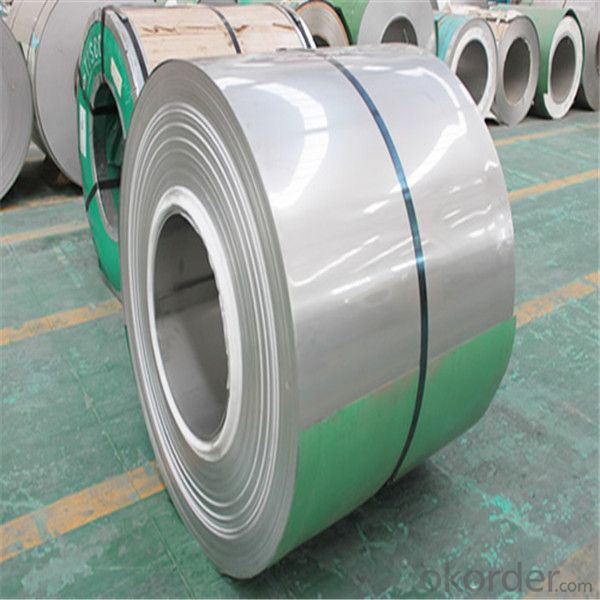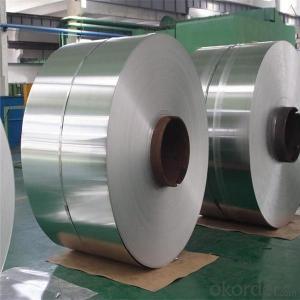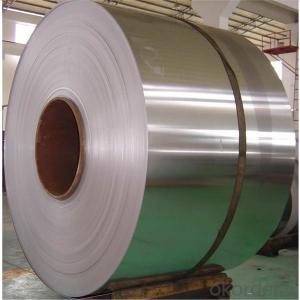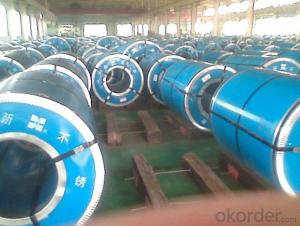201/304/430/ Stainless Steel Coil with good quality
- Loading Port:
- Shanghai
- Payment Terms:
- TT OR LC
- Min Order Qty:
- 5 m.t.
- Supply Capability:
- 24000 m.t./month
OKorder Service Pledge
OKorder Financial Service
You Might Also Like
Item specifice
stainless steel coil
1. Standard: ASTM A240, JIS G4304, G4305, GB/T 4237, GB/T 8165, BS 1449, DIN17460, DIN 17441
2. Grade: 200series&300series&400series
3. Thickness: 0.23mm-0.8mm
4. Diameter: 115-560mm
5. Length: according buyer require
6. Surface finish: 2B, BA, 8K, 6K, Mirror Finished, No1, No2, No4, Hair Line with PVC
7. Manufacture technology: cold drawn/cold rolled/hot rolled
1.Export Markets
Our target market is the international market. Every year we export most of products to countries like India, Pakistan, South Korea, Brazil, Australia, South Africa, Spain, Sri Lanka, russia,vietnam,Taiwan, Hong Kong, etc.
Type | Stainless steel coil (cold rolled ) |
Thinckness | 0.23mm-0.8mm |
Diameter | 115mm-560mm |
Quantity | as customer's requirement |
Finish | 2B,BA,HL,MIRROR,NO.1-NO.4,8K,and so on. |
Standard | ASME, ASTM, EN ,BS,GB,DIN, JIS etc |
Material | 201,202, 301,304,410,430,409 |
Application range | Foodstuff, Gas, metallurgy, biology, electron, chemical, petroleum, boiler, nuclear energy, Medical equipment, fertilizer etc |
Package | Standard export sea-worthy packing |
Delivery time | 7-15 days |
Quality | No.1 |
Productivity | 3000-4000 tons/month |
Note | We can produce other standard as the customers’ requirement |
2.Technical notes:
Surface Finish | Definition | Application |
2B | Those finished, after cold rolling, by heat treatment, pickling or other equivalent treatment and lastly by cold rolling to given appropriate luster. | Medical equipment, Food industry, Construction material, Kitchen utensils. |
BA | Those processed with bright heat treatment after cold rolling. | Kitchen utensils, Electric equipment, Building construction. |
NO.3 | Those finished by polishing with No.100 to No.120 abrasives specified in JIS R6001. | Kitchen utensils, Building construction. |
NO.4 | Those finished by polishing with No.150 to No.180 abrasives specified in JIS R6001. | Kitchen utensils, Building construction, Medical equipment. |
HL | Those finished polishing so as to give continuous polishing streaks by using abrasive of suitable grain size. | Building Construction. |
NO.1 | The surface finished by heat treatment and pickling or processes corresponding there to after hot rolling. | Chemical tank, pipe |
3.chemcial composition
Quality | Copper | NI | CU | Application |
PURE DDQ
| High | 1% | 1.4% | Sink, Deep drawing product |
DDQ | Middle | 1% | 1% | Pot, Bowl |
non-DDQ | Low | 0.5% | 0.5% | Plate, Bowl |


- Q:Are stainless steel strips suitable for kitchen appliances?
- Yes, stainless steel strips are highly suitable for kitchen appliances. Stainless steel is a popular choice for kitchen appliances due to its durability, resistance to corrosion, and ease of cleaning. It offers a sleek and modern appearance that can seamlessly blend with various kitchen styles. Additionally, stainless steel strips provide excellent heat resistance, making them ideal for use in stoves, ovens, refrigerators, and other kitchen appliances.
- Q:Are stainless steel strips suitable for architectural applications?
- Yes, stainless steel strips are suitable for architectural applications. Stainless steel is a versatile and durable material that is widely used in the architectural industry for various applications. It offers excellent corrosion resistance, high strength, and an attractive appearance, making it a popular choice for both interior and exterior architectural elements. Stainless steel strips can be used in a wide range of architectural applications, including wall cladding, roofing, facades, handrails, balustrades, columns, and decorative features. They can be easily shaped, bent, and welded to create customized designs, allowing architects and designers to achieve their desired aesthetics. In addition to its aesthetic appeal, stainless steel is a low-maintenance material that is resistant to staining, scratches, and fading. It is also highly durable and can withstand harsh weather conditions, making it suitable for both indoor and outdoor applications. Furthermore, stainless steel strips are available in various finishes, including brushed, polished, and patterned, providing architects and designers with a wide range of options to choose from. This versatility allows for the integration of stainless steel strips into different architectural styles and designs. Overall, stainless steel strips are an excellent choice for architectural applications due to their durability, corrosion resistance, aesthetic appeal, and ease of customization.
- Q:Can stainless steel strips be used in high-temperature environments?
- Yes, stainless steel strips can be used in high-temperature environments. Stainless steel is known for its excellent heat resistance and can withstand high temperatures without losing its strength or becoming susceptible to corrosion. This makes it a suitable choice for applications that require durability and stability in extreme heat conditions.
- Q:Can stainless steel strips be used in the oil and gas industry?
- Absolutely! The oil and gas industry can indeed benefit from the utilization of stainless steel strips. Renowned for their resistance against corrosion, impressive strength, and long-lasting nature, stainless steel strips prove to be a fantastic choice for a multitude of applications within this sector. The fabrication of pipelines, storage tanks, heat exchangers, and other vital equipment utilized in the processes of oil and gas exploration, production, and refining often relies on stainless steel strips. Given the presence of corrosive substances like sulfur compounds and saltwater, the ability of stainless steel strips to endure such harsh environments while maintaining their structural integrity is of utmost importance. By doing so, they guarantee the safety and dependability of the equipment employed within this industry.
- Q:Can stainless steel strips be used in the wastewater treatment industry?
- Yes, stainless steel strips can be used in the wastewater treatment industry. Stainless steel is a material known for its corrosion resistance, durability, and strength, making it ideal for various applications in wastewater treatment plants. Stainless steel strips can be used in the construction of tanks, pipelines, and other equipment that come into contact with wastewater. In wastewater treatment plants, stainless steel strips are commonly used in the fabrication of screens, filters, and sieves. These components are crucial for removing solid particles, debris, and other impurities from the wastewater. Stainless steel strips are resistant to corrosion caused by the harsh chemicals and contaminants present in the wastewater, ensuring the longevity and effective performance of these components. Additionally, stainless steel strips are also used in the construction of pumps, valves, and fittings in wastewater treatment plants. These components need to withstand high pressure, aggressive chemicals, and continuous exposure to wastewater. Stainless steel's excellent mechanical properties, including high tensile strength and resistance to erosion, make it a suitable choice for such applications. Furthermore, stainless steel is also hygienic and easy to clean, which is essential in the wastewater treatment industry to prevent the growth and accumulation of bacteria and other harmful microorganisms. Stainless steel strips can be easily maintained, reducing the risk of contamination and ensuring the efficiency of the treatment process. Overall, stainless steel strips are a reliable and durable material for use in the wastewater treatment industry. They offer excellent corrosion resistance, strength, and hygienic properties, making them suitable for various applications in wastewater treatment plants.
- Q:Are stainless steel strips suitable for chemical storage tanks?
- Yes, stainless steel strips are suitable for chemical storage tanks. Stainless steel is highly resistant to corrosion, making it ideal for storing various chemicals. It can withstand a wide range of temperatures and is durable, ensuring the integrity and safety of the stored chemicals.
- Q:Are stainless steel strips suitable for use in corrosive environments?
- Stainless steel strips are a perfect choice for use in environments prone to corrosion. The exceptional corrosion resistance properties of stainless steel have earned it a well-deserved reputation as the ultimate material for situations where exposure to corrosive elements is expected. The presence of chromium in stainless steel creates a protective layer on the surface, referred to as the passive layer, which effectively shields the metal from reacting with the surrounding environment. This passive layer acts as a strong barrier against corrosive substances like moisture, acids, and salts, considerably minimizing the risk of corrosion. Furthermore, stainless steel strips can be further fortified with various alloying elements like molybdenum or nickel to boost their resistance against specific types of corrosion. This remarkable versatility ensures that stainless steel strips remain highly dependable and durable, even in the face of highly corrosive environments such as marine settings, chemical processing plants, or coastal regions.
- Q:Can stainless steel strips be used in pharmaceutical industries?
- Yes, stainless steel strips can be used in pharmaceutical industries. Stainless steel is a preferred material in pharmaceutical manufacturing due to its excellent corrosion resistance, high strength, and durability. It is used in various applications such as equipment fabrication, storage tanks, piping, and fittings. Stainless steel is easy to clean and sterilize, which is crucial in maintaining the highest levels of hygiene and preventing contamination in pharmaceutical production environments. Additionally, stainless steel strips offer versatility in terms of size, thickness, and surface finishes, making them suitable for a wide range of pharmaceutical industry requirements.
- Q:Are 111 stainless steel strips suitable for architectural façades?
- Yes, 111 stainless steel strips are suitable for architectural façades.
- Q:What are the common methods of cutting stainless steel strips?
- There are several common methods used for cutting stainless steel strips. 1. Shearing: This method involves using a sharp blade to cut through the steel strip. It is often used for thinner strips and provides a clean and accurate cut. Shearing machines or hydraulic shears are commonly used for this process. 2. Laser Cutting: Laser cutting is a highly precise method that uses a focused laser beam to cut through the stainless steel strip. It is suitable for both thin and thick strips and allows for intricate designs and shapes to be cut. Laser cutting machines are often computer-controlled, ensuring accuracy and repeatability. 3. Plasma Cutting: Plasma cutting is another method used for cutting stainless steel strips. It involves using a high-temperature plasma arc to melt through the metal and create a cut. Plasma cutting machines are versatile and can cut through different thicknesses of stainless steel strips. 4. Water Jet Cutting: Water jet cutting uses a high-pressure jet of water mixed with an abrasive material to cut through the stainless steel strip. This method is suitable for various thicknesses and can produce precise cuts without heat-affected zones. Water jet cutting machines are often computer-controlled, making it ideal for complex shapes and designs. 5. Abrasive Cutting: Abrasive cutting methods involve using abrasive discs or wheels to grind through the stainless steel strip. This method is commonly used for thicker strips and can be performed manually or with the help of power tools such as angle grinders. It is important to consider the specific requirements of the project, such as the thickness and design of the stainless steel strip, when choosing the appropriate cutting method. Additionally, safety precautions and proper equipment should always be used when cutting stainless steel strips to ensure a successful and safe outcome.
1. Manufacturer Overview |
|
|---|---|
| Location | |
| Year Established | |
| Annual Output Value | |
| Main Markets | |
| Company Certifications | |
2. Manufacturer Certificates |
|
|---|---|
| a) Certification Name | |
| Range | |
| Reference | |
| Validity Period | |
3. Manufacturer Capability |
|
|---|---|
| a)Trade Capacity | |
| Nearest Port | |
| Export Percentage | |
| No.of Employees in Trade Department | |
| Language Spoken: | |
| b)Factory Information | |
| Factory Size: | |
| No. of Production Lines | |
| Contract Manufacturing | |
| Product Price Range | |
Send your message to us
201/304/430/ Stainless Steel Coil with good quality
- Loading Port:
- Shanghai
- Payment Terms:
- TT OR LC
- Min Order Qty:
- 5 m.t.
- Supply Capability:
- 24000 m.t./month
OKorder Service Pledge
OKorder Financial Service
Similar products
New products
Hot products
Hot Searches
Related keywords





























